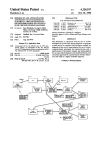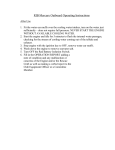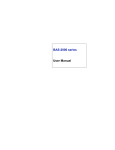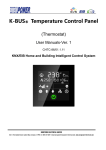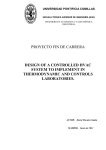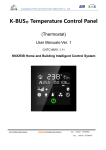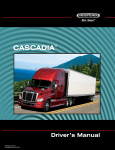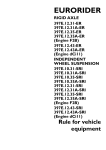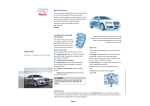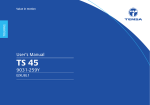Download CONTROLS AND INSTRUMENTS 23
Transcript
CONTROLS AND INSTRUMENTS 23 UTILITY COMPARTMENT KEY KEYS Four different key models are provided with the vehicle. They are used as described below. FRONT ENTRANCE DOOR LOCK KEY UTILITY COMPARTMENT KEY 23344 This key locks or unlocks the utility compartment and the utility drawers on the dashboard. IGNITION SWITCH KEY FRONT ENTRANCE DOOR LOCK KEY 23057 Use this key to lock or unlock the entrance door from outside. It is also possible to lock or unlock the entrance door using the entrance door locking switch, the keyless entry system or the remote entry transmitter. EXTERIOR COMPARTMENTS KEY IGNITION SWITCH KEY 23056 Turn the ignition key counterclockwise to the ACC position to activate the electrical circuits. To start the engine, turn the key clockwise to the START position, and then release it. The key will set back to the ON position. CAUTION EXTERIOR COMPARTMENTS KEY 23302 Use this key to lock or unlock any exterior compartment door, including the fuel tank filling access doors, the baggage compartment doors and electrical/service compartment doors. It is also possible to lock or unlock the baggage compartment from the inside by means of the central locking system switch located on the L.H. dashboard panel. NOTE For your protection against theft: o o Record the key numbers and keep this information in a safe place. Do not keep these records inside vehicle. It is also advisable to deposit a duplicate of each key in a safe place, so they can be obtained without difficulty in case of an emergency or loss. When the vehicle is parked overnight or for an extended period of time, the battery master switch should be set to the OFF position. NOTE When the battery master switch is set to the OFF position, all electrical supply from the batteries is cut off, with the exception of battery equalizer check module, MCM ignition and power supply, TCM power (Transmission), coolant heater electronic timer coolant heater and water re-circulating pump, pro-driver, power-verter, keyless entry system and fire alarm. REMOTE ENTRY TRANSMITTER Up to four hand held (electronic key) transmitters can control electronic door lock system. REMOTE ENTRY TRANSMITTER 23383 24 CONTROLS AND INSTRUMENTS To lock the entrance door and the baggage compartment doors simultaneously and arm the intrusion protection and anti-theft system: o Press LOCK on the transmitter once. NOTE NOTE For complete information concerning the Remote Keyless Entry & Anti-theft Alarm System, refer to the document included in your vehicle “publication box”. IGNITION SWITCH The intrusion protection and anti-theft system will be set after a 30 seconds delay. ACC. OFF ON START To confirm that the entrance door and baggage compartment doors have been locked and that the intrusion protection and anti-theft system is armed: o again within five seconds of Press LOCK the first lock. The front and rear side markers will flash once if the doors have locked. If the entrance door or one of the baggage compartment doors is open, a door ajar signal prevents arming of the system. To unlock the entrance door: o on the transmitter. This Press UNLOCK will unlock the door and disarm the intrusion protection and anti-theft system. To unlock the baggage compartment doors: o a second time within five Press UNLOCK seconds of the first unlock. To set off the personal security alarm: o button on any Press the red PANIC transmitter. The horn will sound and the marker lights will flash for a maximum of three minutes. To deactivate the personal security alarm: o button again on Press the red PANIC any transmitter or turn the ignition key ON. NOTE The remote entry features will not function when the ignition is in the ON or ACC. position. For additional information, refer to "OTHER FEATURES" chapter. IGNITION SWITCH POSITIONS 06354 The ignition switch is located on the lower left side of the dashboard. It has four positions: Off In the OFF position, ignition cannot take place. The key can be removed when in this position. The electrical circuits are not activated when the switch is in this position. Only the accessories connected directly to the batteries can be activated. Maintain the switch in this position when parked overnight or for an extended period. NOTE The main battery relay is activated when the hazard flashers are activated, even if the key is in the OFF position. Accessories To operate the accessories only, turn the ignition key counterclockwise to the “ACC” position. The key cannot be removed in this position. The electrical circuits are activated when the switch is in this position or when the hazard flashers are activated. The features enabled when the key is in the ACC position are all those linked directly to the battery plus the exterior temperature display, the radio or entertainment system, exterior and interior lighting. On To place ignition switch to ON, turn the key clockwise to the first position. The key cannot be removed in this position. CONTROLS AND INSTRUMENTS The electrical circuits activated when the switch is in the ACC position plus the transmission, engine and accessories, ABS system, air dryer heater, wipers, dashboard cluster gauges and buzzers are activated when the key is in this position. Do not leave the key in this position unless the engine is running. Start Turn the key clockwise to the second position and release as soon as the engine starts. The key will return to the ON position. If the engine did not start, return the ignition key to the OFF position before trying to restart the engine. The ignition switch is equipped with a starter protection which inhibits turning the key to the START position if the key has not previously been turned to the OFF position. CAUTION To avoid overheating the starter, do not engage the starter for more than 15 seconds at a time. Allow the starter to cool before trying to restart the engine The features activated when the engine is running are all those described above plus the HVAC system and daytime running lights. The optional ether cold-start system is automatically deactivated once the engine runs. 25 26 CONTROLS AND INSTRUMENTS DRIVER’S AREA 18675 CONTROLS AND INSTRUMENTS LATERAL CONTROL PANEL 27 c TRANSMISSION CONTROL PAD The control pad for the automatic transmission is located as shown. Refer to "Automatic Transmission" in this chapter for operating instructions and more information. d CONTROL SWITCHES Cruise Control Switch Depress the CRUISE rocker switch to activate the cruise control. This turns the system on. A LED on the switch shows that you can now set the vehicle at a desired cruising speed. 06701 The cruise control allows you to cruise the vehicle at a desired speed over 18 mph (30 km/h) without having to use the accelerator pedal. For operation of the cruise control, refer to “Steering Wheel Controls” paragraph in this chapter. Back-up Alarm Cancel Press down this switch to cancel the back-up alarm. Return to normal operation after use. 06311 Horn Selector Use this switch the toggle between the air horn and the electric horn when pressing the steering wheel center pad. 06700 Power Window Switch Use this rocker switch to open or close the driver’s power window. 18676 06338 28 CONTROLS AND INSTRUMENTS NOTE CAUTION Close power window when parked or leaving the coach unattended. Outside Rear View Mirror Heat (Optional) Press this rocker switch to clear fog, frost or thin ice from outside mirror. If the mirror assemblies on your vehicle do not include convex mirrors, only one mirror control knob will be installed for both mirrors. To operate, turn knob to the left for L.H. mirror adjustments and to the right for R.H. mirror adjustments, then use the joystick control to adjust the selected mirror’s viewing angle. f g h LEVEL LOW SYSTEM 06261 Central Locking System This system enables locking all baggage compartment doors by pressing the switch forward. To unlock, press the switch rearward. 06266 NOTE Service compartment doors are not linked to the central locking system. NOTE Doors must be locked using the key first; they can then be unlocked or locked using the central locking system. e MIRROR CONTROLS Convex Flat MIRROR CONTROLS 06374 Turn left pointer knob counterclockwise for flat mirror adjustments and to the right for convex mirror adjustments, then use the joystick control to adjust the selected mirror’s viewing angle. Adjust the right outside mirror similarly but by using the right side control. When driving, the conventional air leveling system of the vehicle controls the height at three points: the front, the left rear and the right rear. Your vehicle is equipped with a suspension system that consists of air springs (pressurized air bellows) located near each wheel. The amount of air in each air spring (and thus the vehicle height) is controlled by automatic leveling valves that operate between the chassis and the axles of the vehicle. The three leveling valves are located as follows: one at the front which controls the amount of air in both front air springs, one at the left rear which controls the left rear corner of the vehicle and one at the right rear which controls the right rear corner of the vehicle. During normal driving, these valves work automatically to maintain the chassis at the proper level above the axles, indifferent of road conditions or vehicle weight. When parked, and ONLY when parked, the level of the vehicle can be manually adjusted within the range of travel of the air springs. Thus, if the vehicle is parked on uneven ground, the manual override leveling system can be used to level the chassis of the vehicle. With the ignition ON (engine running or not), turn the selector switch located on L.H. side control panel to the area of the vehicle requiring leveling, then press the height control switch accordingly (up or down) to inflate or deflate the selected set of air springs. The front position raises or lowers the front only and does not tilt the vehicle to its sides. Each rear position raises or lowers its respective side, therefore, the rear positions can be used to tilt the vehicle to one side or the other, or they can CONTROLS AND INSTRUMENTS 29 be used to raise or lower the rear of the vehicle. When leveling vehicle, it is often necessary to run the engine in order to get an adequate air supply. NOTE It is always better to first level the rear of the vehicle (right to left) before raising or lowering the front. After adjusting the rear, watch the level indicator as you adjust the front. If the level shows that the vehicle is starting to tilt to either side, then stop adjusting the front as one of the air springs has come to the end of its travel range. After manual leveling, turn OFF the engine. The vehicle will stay in the leveled position (the air is "locked" in the air springs) as long as there are no air leaks. The vehicle will hold this position for several days. When engine is restarted and air pressure is adequate, the vehicle will automatically level itself for driving conditions. WARNING Do not drive the vehicle with the level low selector switch in any position other than OFF, as this may render the vehicle unsafe and uncontrollable. If this is the case, the Level Low warning telltale light in dashboard will flash, reminding you that the selector is not in the OFF position. CONTROL VALVES 12224 j TAG AXLE CONTROL VALVE Lift the tag axle by pushing the lever forward. Pulling the lever back will lower (load) the tag axle. Refer to "OTHER FEATURES" chapter for additional information. WARNING Do not drive vehicle with tag axle raised when speed is exceeding 12 mph (20 km/h). k TRAILER AIR SUPPLY CONTROL VALVE (Optional) The trailer air braking system is supplied by pushing this control valve. 12225 NOTE If, for any reason, you wish to start the engine without moving vehicle (to warm up engine for instance) while keeping the vehicle in the manually leveled position, place selector switch in any position except OFF. When ignition switch is turned to the OFF position, reset the Level Low selector switch to the OFF position. i PARKING BRAKES CONTROL VALVE Spring-loaded parking brakes are applied by pulling up the control valve knob and protector assembly. Lift the safety cover and push down to release brakes. Refer to “SAFETY FEATURES AND EQUIPMENT" chapter. 06485 10. Utility Compartment 11. 12-volt DC Power Outlet 12. Ashtray 13. Cigarette Lighter 30 CONTROLS AND INSTRUMENTS (10) (11) UTILITY COMPARTMENT & 12-VOLT DC POWER OUTLET TIRE PRESSURE (TPMS) The lockable free space utility compartment also includes a 12-volt appliance socket. This system is a sensing device designed to identify and display tire operating data and activate an alert or warning when pressure or temperature irregularities are detected. (12) ASHTRAY To open the ashtray, push slightly on the cover’s side. The ashtray can be removed for cleaning by pulling it out. WARNING MONITORING SYSTEM NOTE It is the responsibility of the driver to react promptly and with discretion to alerts and warnings. Abnormal tire inflation pressures should be corrected at the earliest opportunity. To prevent a fire, never put paper or plastic wrappers in the ashtray. Empty ashtray often. (13) CIGARETTE LIGHTER Push lighter in to activate. When ready to use, it will spring out automatically. Replace lighter in non-activated position. The cigarette lighter socket can be used to power 12-volt appliances (eg. flashlight, vacuum cleaner). The maximum power consumption allowed for appliances plugged in this socket is 130 watts. Make sure the appliances are equipped with suitable plugs that will not damage the socket. TPMS Display NOTE The cigarette lighter can still be used after the ignition key has been removed. DIAGNOSTIC RECEPTACLE TPMS DISPLAY DATA READER (DDR) To facilitate troubleshooting of the DDEC, WT and ABS systems and to obtain data logged in the MCM (Motor Control Module) memory, a Diagnostic Data Reader (DDR) (not supplied) can be connected through the DDR receptacle. A user's manual is supplied with the optional DDR. The DDR receptacle is located inside the footwell, on the upper left side wall. The TPMS display knows where the sensors are located. It receives the raw temperature and pressure readings from the TPMS receiver, it reads several signals from the vehicle and does the calculation required to generate the various screens. When no readings have been received for a tire location or when the received data correspond to a parameter range defined as unavailable, then the reading is considered as not available and appears as two dash lines “_ _“. The TPMS display is initially configured to define how many axles and running tires are present on the vehicle. For current Prevost vehicle models, there are two axle / tire configurations. These configurations are: Config 1: Axle 1 (Front) Two tires, Axle 2 (Drive) 4 tires, Axle 3 (Tag) 2 tires. Config 2: Axle 1 (Front) Two tires, Axle 2 (Drive) 2 tires (super Singles), Axle 3 (Tag) 2 tires. The TPMS display is also configured with several other parameters, including threshold levels for the alarms. CONTROLS AND INSTRUMENTS The TPMS display power supply turns OFF when the ignition key is switched OFF. Operation The system will monitor all vehicle tires (6 or 8) plus the spare tire when a spare is supplied. NOTE Some vehicle models do not come with a spare tire. There are two configurations of vehicle tires to be supported. One configuration (the most common) consists of 8 tires total: two tires on the front axle, 4 tires on the drive axle and 2 tires on tag axle. All screen figures shown in this document relates to this vehicle configuration. The second tire configuration consist of 6 tires total: 2 tires on the front axle, 2 tires on the drive axle (super single tires) and 2 tires on the tag axle. The vehicle tire configuration is selected with a parameter (Refer to “SAFETY FEATURES AND EQUIPMENT” chapter for more information). When the display is configured for 6 tires, the drive axle tires appears as one large tire on both side instead of twin tires as illustrated in this document and there is one reading appearing on each side instead of two as illustrated in this document. Start-up When turning the ignition switch to ON, the following screen appears on the TPMS Display. Dash lines are displayed meaning that no pressure data have been received by the display. --- --- PSI -- -- --SPARE TIRE: - PRESSURE DEVIATIONS TARGET PRESSURES GAUGE PRESSURES -- PSI -- -- --1 -- 1 -SPARE TIRE: - PRESSURE DEVIATIONS TARGET PRESSURES GAUGE PRESSURES As illustrated, the pressure readings will appear replacing the dash lines as the TPMS display starts to receive pressure data from the TPMS receiver. It can take 1 minute to get all pressure readings updated since the sensors transmit at a one minute interval. The user can flip through the menus. 31 Pre-Trip Check When one of the preconditions defined to start the pre-trip check is met, the TPM display enters into a pre-trip check routine and the screen shown below appears. The preconditions to initiate the pre-trip are: Park brake removed Or No activity on the display menu keys for a defined time (Key pressed timeout). After a pretrip, the display is in a “drive” mode with bottom menu replaced by the alarm status. The display remains in this mode until one of the following occurs: A menu key is touched while the park brake is applied, or the park brake does a transition from released to park brake applied. --- --1 PSI -- -- 1 -SPARE TIRE: - - PRE-TRIP CHECK IN PROGRESS During the pre-trip check, the pressure readings for the different wheels become all available. The pre-trip check ends, either when: the pressure readings have been received for all running wheels or the pre-trip check maximum time has elapsed. It was selected to provide sufficient time for all wheel sensors to wake-up and send a first reading. The pre-trip check is aborted and the bottom menu reappears if the park brake was active and the user press one of the menu keys. Upon completion of the pre-trip check, the TPMS display will come up with one of the following screens: 32 CONTROLS AND INSTRUMENTS The switching to temperature works when the bottom message indicates either: Tire Pressure OK, Pressure Not Optimal non flashing or not all tires monitored non flashing. When the switch is done to temperature readings, the bottom portion of the screen is not affected and still shows the status message. NOTE A rectangle around each pressure/temperature reading of the tires that have an issue is blinking to draw the attention to the defective tires. In the case of multiple errors at the same time, the highest priority error is displayed at the bottom. “Flat Tire” has the highest priority followed by “High Temperature”, “Not all tires monitored” and “Tire pressure not Optimal”. To get the driver’s attention to the alarms, the bottom section of the screen where the alarm message appears will blink to reverse contrast at the following rate: 0.7sec normal contrast, 0.3 sec reverse contrast. Pressing any key will acknowledge the alarms that are considered as non critical and stop the blinking of these alarms message for the remaining of the trip. The non critical alarms are: “Pressure not optimal” and “Not all tires monitored”. The “flat tires” and “high temperature” alarms are critical and will keep blinking even when a key is pressed. If a different alarm occurs, blinking will start again. The blinking rectangle around the pressure/temperature readings is not impacted by the acknowledgement and keeps blinking until the error condition disappears. The spare tire does not contribute to alarms and so never blinks. On the road, the TPMS display shows one of the 5 previous screens. In the event of a temperature alarm, the display switches automatically to temperature readings. The driver can also press any of the menu keys to momentary switch the display to temperature readings. In this case, the temperature reading appears for 15 seconds and the display returns to pressure. The switching to temperature by pressing a key does not take place if there is an acknowledgeable alarm active, since in this case pressing the key does acknowledge the alarm. The switching to temperature does not take place either if there is an alarm of Temperature or Flat Tire. High temperature is not likely to occur during the pre-trip. The pressure and temperature readings are continuously updated with the displayed readings of the wheel having issues blinking. The bottom line message is automatically updated to the highest priority alarm prevailing. There is a hysteresis on the alarm levels to assure that the error conditions do not flicker ON and OFF. On the occurrence of an alarm, a beep will sound. The alarm beep could be turned OFF in the alarm settings menu. Spare tire: The spare tire is monitored but it is not taken into account when setting the bottom alarm messages. This is to prevent unnecessary alarms that would otherwise occur, if for example, the spare tire is removed from a vehicle. The user will have the possibility to check the pressure of the spare tire by accessing the TPMS display menu. For vehicles that have no spare tires, the title “spare tire:“ will still appear on the screens but the pressure will remain with two dash lines at all time. Post Trip Operation When parking the vehicle (park brake applied), the TPMS display keep the drive mode display active. The driver can press any keys to get the bottom lines showing the status information replaced with the menus. The pressure readings are still displayed and updated as new readings are received and the readings are blinking if not within the optimum pressure range. From this point the user can scroll through the menus to get more detailed information and inflate/deflate the tires to bring them back to their optimum target pressures. Scrolling through these menus is also available prior to departure. CONTROLS AND INSTRUMENTS The display remains in this mode with the menus appearing at the bottom until the pre-trip check sequence starts again. Scrolling down below the Battery life menu will show the Settings menu. Highlighting the Settings and pressing OK allows entering the settings menu. Refer to “SAFETY FEATURES AND EQUIPMENT” chapter for more information on “Settings Menu”. Highlighting the Exit menu and pressing OK exits the settings and come back to the pressure display mode. 33 34 CONTROLS AND INSTRUMENTS DASHBOARD DASHBOARD 1. L. H. DASHBOARD PANEL 2. MCD KEYPAD 3. TELLTALE PANEL 4. GAUGES 5. VEHICLE CLEARANCE INFORMATION 6. R.H. DASHBOARD PANEL 7. HVAC CONTROL UNIT 8. BRIGHTNESS CONTROL 9. MESSAGE CENTER DISPLAY (MCD) 10. IGNITION SWITCH 11. TIRE PRESSURE MONITORING SYSTEM DISPLAY (TPMS) 12. ADJUSTABLE AIR REGISTERS 06698 CONTROLS AND INSTRUMENTS 35 CONTROL SWITCHES High quality laser-engraved switches are used to control many of the features of the coach. Many switches have an embedded witness LED to inform the driver at a glance which features are active. Some switches' LED will turn OFF after a short while when the engine is running. This is normal and is designed to reduce glare when driving. The functions still operate even if the LED is OFF. If the switches are still ON when the engine is turned OFF, the LEDs will illuminate to warn the driver to turn them OFF. L. H. DASHBOARD PANEL The L.H. dashboard panel includes driver-exclusive controls, ether start control switch, ignition switch and an adjustable air register for the driver. L. H. DASHBOARD PANEL 06711 Headlights and Exterior Lighting 06254 OFF position – Daytime running lights only. Press this rocker switch to turn on the following lights: First position – Front parking lights, taillights, clearance lights, marker lights, license plate light. Second position (push down fully) - the headlights, the controls and instrument lights and all lights from the first position. NOTE Daytime running lights will be automatically cancelled when the exterior lighting switch is fully depressed (second position). Fog Lights (Optional) Optional halogen fog lights provide better visibility in fog and precipitation. They improve close range visibility and provide added safety. NOTE 06255 Some states and provinces restrict the use of fog lights. Verify local state or provincial regulations before using. 36 CONTROLS AND INSTRUMENTS Hazard Warning Flashers Press the rocker switch to make all turn signal lights flash at once. The dashboard telltale lights will flash when the hazard warning flashers are ON. CAUTION 06256 Do not use the hazard flashers for an extended period of time unless necessary because the electrical circuits are activated when the hazard switch is depressed. Upper Windshield Wipers (Optional) Press the rocker switch to the first position to activate the upper wipers intermittently. Press to the second position for continuous operation of the upper wipers. CAUTION 06257 To avoid damaging the wiper blades or scratching the windshield, do not operate the wipers when the windshield is dry. Also, loosen frozen wipers before operating. NOTE Lower windshield wipers are activated using the multi-function lever. Refer to paragraph: “Steering Column Controls” in this chapter. Upper Windshield Washer (optional) & Headlights Washer Press this rocker switch upwards to spray the upper windshields with washer fluid. Windshield wipers will automatically come on and stop a few seconds after releasing the switch. Momentarily press this rocker switch downwards to spray the headlights washer fluid. Each pressing of this switch produces 2 successive jets. 06615 CAUTION Do not operate the washer mechanism while the washer fluid reservoirs are empty. This may damage the washer fluid pumps. NOTE Lower windshield wipers are activated using the multi-function lever. Refer to paragraph: “Steering Column Controls” in this chapter. Low Docking Press the rocker switch to reduce cornering and docking lights intensity. 06486 CONTROLS AND INSTRUMENTS 37 Docking / Cornering Press this rocker switch upwards (DOCKING) to illuminate the cornering and docking lights. Press this rocker switch rearwards (CORNERING) to illuminate the cornering lights when signaling a left or right turn. 06337 Manual Regeneration / Stop Regeneration Manual Regeneration DPF Regeneration Lamp The «DPF Regeneration Lamp» illuminates to notify the driver of the need and urgency of a manual stationary regeneration. 06660 If stationary regeneration is not performed, this telltale will blink, indicating that a stationary regeneration is required immediately. If stationary regeneration is still not performed, “engine power derate and shutdown” sequence may occur. To initiate a stationary regeneration: • Park the vehicle in a clear area, vehicle speed must be 0 mph (0km/h); • Engine must be on normal idle and fully warmed up (coolant temperature above 140°F/60°C); • Apply service brakes and set the transmission to the neutral “N” position. • While maintaining the service brakes applied, apply parking brake, release it and then apply parking brake once again (this sequence is required to enable the stationary regeneration); • Press and hold for 5 seconds the top-most switch position to initiate a stationary regeneration; The regeneration will begin. Turn off the air conditioning to reduce engine load. The engine idling speed will increase to 1600 rpm. Once the regeneration is completed, the engine speed will return to normal idle. Stop Regeneration Inhibit Regeneration Lamp The «Inhibit Regeneration Lamp» illuminates to indicate the system’s acknowledgement of regeneration inhibit request and to remind the driver that regenerations have been or will be inhibited. Press down to cancel a regeneration that is in progress or to inhibit a pending regeneration. Use this function to move the vehicle to a safe parking place. Releasing the parking brakes will also cancel the regeneration. 38 CONTROLS AND INSTRUMENTS NOTE STATIONARY REGENERATION This process requires the vehicle to be parked while the driver or a maintenance technician initiates the regeneration process. NOTE To initiate a stationary regeneration while the Engine Protection Shutdown sequence has already started, you must press and hold both the «Engine Stop Override» switch and the «Manual Regeneration» switch at the same time until the regeneration starts. Once started, the regeneration may last for only a few minutes and engine may shut down again. Repeat the operation as required until the stationary regeneration can be completed. CAUTION Before initiating stationary regeneration or using the inhibit regeneration function, read carefully and understand paragraph “Detroit Diesel Exhaust Aftertreatment System” in Chapter 4 “OTHER FEATURES” for complete information concerning regeneration precautions. Ignoring them could result in extensive damage and/or serious personal injury. Fast Idle For extended idling periods, run the engine at fast idle. Press down the rocker switch to engage fast idle. This increases the engine speed to approximately 1,000 rpm. Return to normal idle before driving or when stopping engine. CAUTION 06264 Even if normally the engine will return to normal idle and remain there if the parking brake is applied and/or transmission is placed in neutral (N), it is safer to first press down the rocker switch to run the engine at normal idle before engaging the transmission. CAUTION Return the engine to normal idle before shutting the engine OFF. Engine Brake / Transmission Retarder Use this switch to select between the transmission retarder and the engine brake when using the vehicle speed retarding device switches on the steering wheel. Both systems cannot be in function at the same time. This rocker switch can be found on the dashboard, only if the vehicle is equipped with both systems. Refer to "Transmission Retarder” heading in this chapter. Refer also to "Transmission Retarder” & “Engine Brake” in “OTHER FEATURES” chapter. 06703 CONTROLS AND INSTRUMENTS 39 Engine Stop Override Press this switch then release to override the emergency engine shutdown protection. Engine emergency shutdown will be turned OFF for 30 seconds. This procedure can be repeated if done before the 30 seconds are up. 06265 CAUTION Use sparingly and in order to move the vehicle to a safe parking place only. Excessive use can cause severe engine damage. DDEC Diagnostic Request With the engine at idle or OFF and with the ignition switch in the ON position, press and release the Engine Stop Override rocker switch. Active codes will be flashed on the “ Stop Engine “ and inactive codes on the “ Check Engine “ telltale lights alternately. Refer to Appendix D “DDEC VI Diagnostic Codes”. Telltale Light Test Press down and maintain this switch at least 2 seconds to illuminate the telltale light panel. The telltale panel audible alarm will sound. Perform this test to verify indicator light and telltale panel audible alarm functionality. 06263 Ether Start Control (Optional) Activates the engine cold starting aid. chapter. Refer to "STARTING CAUTION 06237 Excessive use may result in severe engine damage. AND STOPPING PROCEDURES" 40 CONTROLS AND INSTRUMENTS R.H. DASHBOARD PANEL R.H. DASHBOARD PANEL 06562 Driver's Area Lighting Press the rocker switch to turn on the driver's overhead light as needed. NOTE 06244 The entrance overhead light and the stepwell lights turn on with the entrance door opening and turn off with door closing. If the entrance door is left opened, these lights will be turned off automatically if the batteries voltage drops below 24.0 volts. Back-up Camera Press this switch to activate the back-up camera monitor when the transmission is not in the reverse gear. 06314 Front Entrance Door Press this switch forward to lock the entrance door from the inside. To unlock the entrance door from the inside and disarm the intrusion protection and anti-theft system, press the switch rearward. NOTE 06313 When the alarm system is armed, unlocking the entrance door from the inside by sliding its lock lever will not disarm the alarm system. The alarm will sound. Brightness Control Adjusts the brightness of the dashboard instruments and switches. 06565 CONTROLS AND INSTRUMENTS To prevent battery run-down, the central A/C and heating systems will not operate if the charging system is not working properly. HVAC CONTROL UNITS Vehicles equipped with small HVAC system CONTROL UNIT FOR SMALL HVAC SYSTEM 41 22286 The temperature control in the driver’s area is provided directly by the driver section of the HVAC control unit. Using the Up/Down type switch sets the fan speed and the speed chosen is illustrated on the window display. In addition to the driver’s unit, the small HVAC system also includes an auxiliary unit which uses the temperature control of the driver section of the control unit. The R.H. section of the control unit AUX. FAN enables to actuate the auxiliary unit and to regulate its fan speed. Using the < > type switch sets the fan speed and the speed chosen is illustrated on the window display. Vehicles equipped with central HVAC system When the A/C system is running, park at least 4 feet (1,5 m) from other vehicles or buildings to allow sufficient air flow through the condenser core. Separate driver and passenger heating, ventilation and air conditioning controls are located on this control unit. To operate, the vehicle’s engine must be running. The driver section and the passenger section of the control unit may be turned ON by pressing the following button: 06372 Also, the driver section of the control unit turns on automatically at starting of the engine and uses the settings that were kept in memory before turning off of the system. The A/C compressor starts automatically when the two following conditions are satisfied: 1. The outside temperature is above 32°F (0°C). 2. The passenger's area temperature has reached 7°F (4°C) under the set point. NOTE CONTROL UNIT FOR CENTRAL HVAC SYSTEM 22276 The vehicle is slightly pressurized by the central HVAC system to prevent dust and moisture from entering. Air flow and controls divide the vehicle into two areas: driver’s area with defroster and passenger's (cabin) area. Fresh air is fed in each area and has a separate return air and discharge air duct. NOTE To operate the air conditioning system when stationary, run engine at fast idle. When the system is running, keep windows and door closed. Upon starting, if the outside temperature is above 32°F (0°C) and then drops below 32°F (0°C), the compressor will keep running up to a temperature of 15°F (-9°C) to prevent condensation from forming on the windows. All parameters set before turning the system OFF will be kept in memory for the next power ON. HVAC Air Registers The HVAC system has registers to control air flow around the driver’s and navigator’s area. • Three are located on the dashboard, two on the R.H. side and one on the left. • Two more registers are located near the steering wheel column, under the dashboard. These registers are not adjustable but may 42 CONTROLS AND INSTRUMENTS be electrically open or closed by means of the HVAC control panel. • Three auxiliary unit registers are located behind the driver (with small HVAC system only). • For the navigator, two adjustable registers are located near the entrance door, at bottom of first lateral window. Heating Mode Indicator This red LED illuminates when system is heating. 22135 Cooling Mode Indicator This green LED illuminates when the system is cooling (when the compressor clutch is engaged). 22134 NOTE DASHBOARD AIR REGISTER 22287 Both Heating Mode and Cooling Mode indicator LED can illuminate simultaneously. During winter, if the outside temperature is above 32°F (0°C), the A/C compressor may start for dehumidification purposes to prevent condensation from forming on the windows. During summer, the Heating Mode may activate to regulate inside temperature. Fan Speed NAVIGATOR’S AIR REGISTER & FAN SPEED SELECTOR Navigator fan speed switch Upon turning on of the HVAC control unit, both right and left windshield defogging/defrosting fans speed is set according to the driver section settings of the control unit. The navigator can afterwards, use this switch to increase or decrease the right windshield defogging/defrosting fan speed as needed. Navigator air registers On small HVAC system, these registers are part of the auxiliary unit. Use the auxiliary unit fan speed switch on the R.H. portion of the control unit (AUX. FAN) to regulate the fan speed. Doing so will also reduce air from the three registers located behind the driver. On vehicles equipped with the Central HVAC system, these registers are supplied in air by the passenger’s (cabin) unit. 22135 This switch controls both right and left windshields defogging/defrosting fans speed. Increase speed by pressing on the upper portion of the button, decrease by pressing on the lower portion. Auxiliary Unit Fan Speed (With Small HVAC System Only) Use this switch to increase or decrease the auxiliary unit fan speed by pressing on the right or left 22289 portion of the button. Recirculate Closes or opens the driver's and passenger's section fresh air damper. 22138 A red LED in the top right corner of the button illuminates when air is recirculating. Use for faster section heating. This feature is automatically cancelled when defogging is activated. CONTROLS AND INSTRUMENTS Driver's section temperature setting The temperature displayed on the driver section of the control unit is the temperature set point. 22132 Windshield Defogger/Defroster Upon pressing this button, the dashboard damper sends air only to the lower windshield. The fans are turned on to maximum speed, the fresh air damper opens completely (REC off) and the driver set point is increased to 4°F (2°C) over the passenger's section set point. To increase the temperature set point, press on the "+" sign, to decrease the temperature set point, press on the " - " sign. Temperature range is between 60°F and 82°F (16°C to 28°C). On the driver section only, asking for a temperature set point of 82°F (28°C) will keep the coolant valve open. In case of interior temperature sender unit failure, the coolant valve will remain open and three lines “---“ will be displayed. WARNING Warm temperatures may cause drowsiness and affect alertness while driving. Keep the temperature comfortable but not to high. 22139 22132 To increase or decrease the temperature set point, press on the "+" or the " - " sign. Pressing these buttons will flash the displayed set point and the word "SET" will highlight. Temperature range is between 60°F and 82°F (16°C to 28°C). In case of interior temperature sender unit failure, the coolant valve will remain open and three lines “---“ will be displayed. NOTE Upon starting of the vehicle, when the ambient temperature is very cold and so is the inside of the vehicle, the HVAC control unit will permit a temperature overshoot up to 3° over the passenger’s area set point to help warming up of the area. The dashboard damper sends air only to the lower windshield when activated. The footwell damper is closed also but the fans speed can be reduced or increased. Panel and Footwell The dashboard damper sends air to the panel vents and footwell. 22137 Panel 22136 Passenger's (cabin) section temperature setting (with Central HVAC System) The temperature displayed on the passenger section of the control unit is the actual temperature in the passenger's area. 43 Air is sent to panel vents. The foot damper is closed. Temperature Degree Selector Toggles the HVAV control unit temperature units between Fahrenheit and Celsius. The driver’s section must be on. Also toggles the outside 22133 temperature units displayed on the telltale panel. 44 CONTROLS AND INSTRUMENTS CLUSTER CLUSTER 06710 The cluster incorporates the Message Center Display, the Telltale Panel, the Gauges and Vehicle Clearance Information. Engine Oil Pressure Indicates engine oil pressure. The normal reading should be between 50 and 70 psi (345 480 kPa) at 55 mph (90 km/h). MESSAGE CENTER DISPLAY (MCD) 06229 06399 This standard feature gathers, stores and displays important information about the vehicle’s operation on a display screen on the lower left portion of the cluster. Refer to Message Center Display in “OTHER FEATURES” chapter for a description of how to set up and operate the Message Center Display. A low oil pressure indicator LED (bottom right corner of gauge) illuminates when the MCM decides oil pressure is too low. In such a case, the MCM will start to power down the engine until finally shutting it off as explained under “STOP Engine” telltale light, in this chapter. An audible alert signal also informs the driver of low oil pressure. Refer to “SAFETY FEATURES AND EQUIPMENT” chapter for table of audible alerts. GAUGES NOTE Do not refer to dashboard instruments during adjustment procedures. Use only calibrated gauges. CAUTION Loss of oil pressure may cause severe engine damage. If low oil pressure LED illuminates, park the vehicle safely and stop the engine immediately. Request service assistance. CONTROLS AND INSTRUMENTS Engine Coolant Temperature Indicates the operating temperature of the engine coolant. The normal reading should be between 190°F and 222°F (88°C to 106°C). 06231 A high coolant temperature indicator LED (bottom right corner of gauge) illuminates when the coolant temperature rises above 223oF (106oC). An audible alert signal also informs the driver of this condition. Voltmeter (24-Volt System) Indicates the condition of the 24-volt electrical system. With the engine running, the normal reading should be between 26.5 and 28.0 volts. 06224 Fuel Level Indicates the amount of fuel remaining in the fuel tank. The engine protection system will start power down. Refer to “SAFETY FEATURES AND EQUIPMENT” chapter for table of audible alerts. 06225 Turbo Boost Pressure Indicates turbo boost pressure in psi. Reading depends on engine rpm and load conditions. 06230 Tachometer Indicates the operating speed of the engine in hundreds of revolutions per minute (rpm x 100). The tachometer serves as a guide for gear shifting and Speedometer Indicates the vehicle speed in miles per hour (mph) and kilometers per hour (km/h). 06222 The digital odometer records the distance traveled in miles or in kilometers (units are driver selectable). A telltale light illuminates when about 12 US gallons (45 liters) of fuel remain in the fuel tank. CAUTION Operating the vehicle when the reading is below 1/8 full is not recommended. Accessories Air Pressure Indicates the accessories air system pressure. The normal operating pressure is from 95 to 125 psi (655 to 860 kPa). 06226 Primary System Air Pressure (Rear) Indicates the primary air system pressure. The normal operating pressure is from 95 to 125 psi (655 to 860 kPa). 06221 helps to prevent engine over-speeding when driving downhill with the JACOBS engine brake operating. The maximum allowed engine speed is 2,450 rpm. 45 06228 A low air pressure indicator LED (bottom right corner of gauge) illuminates when the primary air system pressure drops below 66 psi (455 kPa). An audible alert signal also informs the driver of low air pressure. Refer to “SAFETY FEATURES AND EQUIPMENT” chapter for table of audible alerts. If the air pressure drops below 40 psi (276 kPa), the emergency brake applies at full capacity. WARNING Do not drive the coach when air pressure is low. 46 CONTROLS AND INSTRUMENTS Secondary System Air Pressure (Front) Indicates the secondary air system pressure. The normal operating pressure is from 95 to 125 psi (655 to 860 kPa). 06227 A low air pressure indicator LED (bottom right corner of gauge) illuminates when the secondary air system pressure drops below 66 psi (455 kPa). An audible alert signal also informs the driver of low air pressure. Refer to “SAFETY FEATURES AND EQUIPMENT” chapter for table of audible alerts. If the air pressure drops below 40 psi (276 kPa), the emergency brake applies at full capacity. WARNING Do not drive the coach when air pressure is low. Vehicle Clearance Information 00012 Safe vehicle clearance height is 12’10" (3.9 m). CAUTION Vehicle clearance is higher when the ventilation hatch is open, Hi-Buoy is selected or if additional equipment is installed on the roof. CONTROLS AND INSTRUMENTS 47 TELLTALE PANEL TELLTALE PANEL 06652 The telltale lights illuminates during 5 seconds at the start of every ignition cycle as a light bulb check. Some telltale lights described below appear on the telltale panel only if the corresponding optional equipment is installed on the vehicle. Slide-Out Illuminates when one or both slide-outs are partially or fully extended. Blinks to indicate that an error condition has been detected (refer to “OTHER FEATURES” chapter). 06559 Baggage Compartment Door Unlocked Illuminates when one or more baggage compartment doors are unlocked. 06387 Flat Tire (with optional Tire Pressure Monitoring System) Illuminates when a tire pressure is 25% below the target tire pressure. 06694 Fuel Filter/Water Separator Illuminates when accumulated water in the optional fuel filter/water separator needs to be drained. Refer to “CARE AND MAINTENANCE” chapter. 06291 Level Low System Indicator Illuminates when the vehicle leveling system is activated. 06297 06272 Antilock Brake System (ABS) Illuminates when the ABS is not available or when the ABS is malfunctioning. Since the ABS system does not operate at less than 4 mph (7 km/h), the indicator will remain illuminated until the coach reaches that speed. Refer to "OTHER FEATURES" chapter. Driver Controlled Differential Lock (DCDL) Illuminates when the differential action is locked 06272 Trailer Emergency / Parking brake 06591 Illuminates when the trailer emergency/parking brake is unexpectedly applied as when the vehicle is moving and a parking brake air line rupture happens. 48 CONTROLS AND INSTRUMENTS Trailer Antilock Brake System (ABS) Illuminates when the trailer ABS is malfunctioning. 06585 ATC Automatic Traction Control (ATC) Illuminates when the automatic traction control system intervenes to prevent excess wheel spin during acceleration. Left Turn Signal Flashes when the left turn signals are activated. Signal right and left turns by operating the multi-function lever. See “Steering Column Controls” in this chapter. 06290 NOTE The directional signals are automatically activated when the vehicle is backing up. Emergency Window Open Illuminates when an emergency window is open or unlocked. 06572 Baggage Compartment Door Ajar Illuminates when one or more baggage compartment doors are ajar. 06573 Engine Door Ajar Illuminates when the engine compartment door is ajar. 06592 High Exhaust System Temperature Lamp (HEST Lamp) Illuminates to notify the driver of potentially hazardous exhaust gas temperature at the DPF outlet. WARNING 06654 06655 During regeneration, exhaust temperature may reach up to 1200°F (650°C) at the diesel particulate filter. When parking the vehicle, if this warning light is illuminating, make sure that the DPF outlet diffuser is away from people or any flammable materials, vapors or structures. Malfunction Indicator Lamp (MIL) Indicates a failure of an Emission Control device. May illuminate at the same time as the “Check Engine” Amber Warning Lamp. The lamp will go out when the fault is inactive. Vehicle can be driven to end of shift. Call for service. CONTROLS AND INSTRUMENTS 06656 49 Check Engine (Amber Warning Lamp) Indicates a minor fault detected by DDEC VI system. This warning lamp is illuminated for all active faults. The warning lamp will remain ON until the malfunction has been corrected. Vehicle can be driven to end of shift. Call for service. A diagnostic code will be stored in the memory and the lamp can be used to identify the problem. Refer to Appendix D under "DDEC VI Diagnostic Codes". 06657 STOP Engine (Red Stop Lamp) Illuminates when a potential engine damaging fault is detected. Immediately park the coach in a safe place and stop the engine. Flashes when Engine Protection Shutdown occurs. When a problem is detected, the engine power will automatically begin to decrease gradually, followed by full shutdown after 30 seconds. The Engine Protection Shutdown may be bypassed by using the “Engine Stop Override" switch on the L.H. lower control panel. Use only in order to move the vehicle to a safe parking place and then shutdown the engine. Call for service. NOTE Once the engine is stopped, it cannot be restarted until the problem has been corrected. A diagnostic code will be stored in memory. The STOP engine indicator can be used to identify the problem. Refer to Appendix D under "DDEC VI Diagnostic Codes". 06282 Check Transmission When the "CHECK TRANS" indicator is illuminated and the shift selector emits short beeps for 8 seconds, the transmission control module (TCM) is restricting transmission shifting because special or abnormal conditions are detected. The control pad display will be blank. If this happens, drive the coach to the next available service center to receive assistance. The TCM will not respond to shift selector requests since operating limitations are being placed on the transmission (i.e. upshifts and downshifts may be restricted). Direction changes and shifts to and from neutral (N) will not occur. Any time the CHECK TRANS telltale light illuminates, the transmission control module will register a diagnostic code. It may be identified on the display (Allison & ZF-Astronic transmission) or by using a diagnostic tool. Refer to Appendix C. NOTE The CHECK TRANS indicator may also illuminate when starting the engine in extremely cold weather. Refer to "Starting and Stopping Procedures". Transmission fluid Temperature Illuminates when the transmission fluid temperature is too high. An audible alert signal also informs the driver of this condition. Disengage the retarder to allow the oil temperature to cool down. 06292 50 CONTROLS AND INSTRUMENTS Windshield Washer or Headlights Washer Fluid Low Illuminates when the windshield washer or the headlight washer fluid level is low. The washer fluid containers are located inside the front service compartment. 066001 WARNING Do not drive without sufficient washer fluid. 06286 Fuel Level Low Illuminates when approximately 12 US gallons (45 liters) of fuel remains in the tank. After the light comes ON, the remaining fuel will provide no more than 60 miles (100 km) of travel. Do not exceed this distance. NOTE Refuel as soon as possible. 06284 Cruise Control Enabled Illuminates when cruise control is enabled. Right Turn Signal Flashes when the right turn signals are activated. Signal right and left turns by operating the multi-function lever. See “STEERING COLUMN CONTROLS” in this chapter. 06289 NOTE The directional signals are automatically activated when the vehicle is backing up. 06696 Freezing Conditions The word ICE is momentarily displayed when the temperature is in the range between 2°C and 1°C (35°F to 34°F), when the road is most slippery. The rest of the time, the exterior temperature is displayed at this location. Emergency/Parking Brake 06303 Illuminates when the emergency/parking brake is applied. The control valve is located on the L.H. control panel. An audible alert will sound if ignition is turned to OFF and the parking brake is not engaged. Stoplights ON 06305 Illuminates when rear stoplights illuminate. This occurs when service brake, engine retarder or transmission retarder is applied and when the parking brakes are applied with engine running. High Beam ON 06300 Illuminates when high beams are selected. High and low beams are selected by operating the multi-function lever. Refer to “Steering Column Controls” heading in this chapter. CONTROLS AND INSTRUMENTS 51 Fire Detected Illuminates if a fire is detected in the engine compartment while the vehicle is on the road. An audible alert informs the driver when a fire is detected. In case of fire detection when parked (parking brake applied, engine running or not), the electric horn is activated to alert the driver. Refer to “SAFETY FEATURES AND EQUIPMENT” chapter. 06288 WARNING In case of a fire, stop the vehicle immediately, stop the engine and evacuate the vehicle. NOTE It is possible to cancel an alarm while on the road. To do so, stop the vehicle. Cycle the ignition between the ON and OFF position and then start the vehicle normally. This can be done on a temporary basis when a false alarm is activated by a defective fire detector. The driver can go on without being annoyed by the alarm. NOTE To stop the electric horn alarm when parked, cycle the ignition between the ON and OFF position twice within 3 seconds. NOTE For extinguisher's location, refer to “Safety Features And Equipment” chapter. 52 CONTROLS AND INSTRUMENTS Battery Voltage Incorrect 06588 Illuminates when the battery voltage is too high, too low or not equalized. NOTE To identify the battery problem (too high, too low or not equalized voltage), using the message center display (MCD), perform a system diagnostic by selecting SYSTEM DIAGNOSTIC, FAULT DIAGNOSTIC & ELECTRICAL SYSTEM and see the fault messages. NOTE The high/low battery voltage indicator will illuminate for a few seconds after the engine is started because of the voltage drop when the starter is engaged. NOTE To prevent discharge of the batteries when the engine in not running, some functions are automatically switched off if the batteries voltage drops below 24.0 volts for more than 30 seconds. The "BAT" telltale light blinks while this protection mode is active. Set the ignition key to the OFF position and then turn the ignition key to the ON position to reactivate the functions for a period of 30 seconds before they switch off again. NOTE If the battery equalizer indicator illuminates, make sure that the battery equalizer circuit breakers are reset before requesting breakdown assistance. Wait 15 minutes after setting breakers to allow batteries to equalize. The breakers are located in the main power compartment. Alternator Illuminates when one of the alternators is not charging. 06586 NOTE To identify which alternator is defective (1=lower, 2=upper), using the message center display (MCD), perform a system diagnostic by selecting SYSTEM DIAGNOSTIC, FAULT DIAGNOSTIC & ELECTRICAL SYSTEM and see the fault messages. 06271 Retracted Tag Axle Illuminates when the tag axle is retracted. The telltale panel audible alarm will sound to warn the driver. The control valve is located on the L.H. lateral console. CONTROLS AND INSTRUMENTS 53 A/C System Pressure High Or Low Illuminates when the A/C system pressure is too low or too high. 06658 If the A/C pressure is too low, the compressor clutch disengages and the fan stops. If the A/C pressure is too high, the compressor clutch is disengaged, but the fan remains activated. Refer to the Maintenance Manual for information on control panel troubleshooting mode. NOTE When outside temperature is low or high, it is possible and normal for that telltale light to come ON. STEERING COLUMN CONTROLS Many of the most frequently used controls are conveniently placed on the steering column or the steering wheel, just like a passenger car. The Multi-function lever is located on the left side of the steering wheel while the optional transmission retarder lever is located on the right side of the steering wheel. Switches for the electric horn and the air horn are located directly on the steering wheel. MULTI-FUNCTION LEVER Lane Change Signal (2) Move the lever part way to the catch position and hold until the lane change maneuver is completed. The lever will spring back into the OFF position once released. Headlight Beam Toggle Switch (3) Toggle between high and low beams by pulling the lever up towards you. To flash the headlights, pull the lever up halfway. The lever will spring back into normal position once released. Courtesy Blinkers (4) Clearance and parking lights can be flashed by pressing the button located on the lever tip. Windshield Washer Control (5) Push the external ring at the end of the lever toward the steering column to activate the lower windshield washers. The wipers come ON and continue wiping for a few seconds after the ring is released. MULTI-FUNCTION LEVER 23133 The multi-function lever is used to operate the following: Turn Signal (1) Move the lever all the way up until it locks in position to signal a right turn. Move the lever all the way down until it locks in position to signal a left turn. The lever automatically returns to the horizontal OFF position once the turn is completed. WARNING Before using the windshield washers in cold weather, heat the windshield with the defroster to prevent icing and reduced visibility. CAUTION To avoid damaging the pump mechanism, do not use the windshield washer when the fluid level is very low or empty. 54 CONTROLS AND INSTRUMENTS Windshield Wipers (6) Turn the lever counterclockwise to activate the lower windshield wipers. The first position activates the wipers intermittently. The second position is the slow speed and the third position is for high speed wiping. CAUTION To avoid scratching the windshield, do not operate the wipers when the windshield is dry. To avoid damaging the wiper motor, free wiper blades that may be frozen to the windshield before operating the wipers. reached. Press and release the SET button. 2. Press and hold the RES (RESUME) button until the desired cruising speed is reached. When the RES button is released, the new cruising speed will be stored in the cruise control memory. 3. When driving with cruise control, each time the RES button is momentarily depressed, the cruising set speed is raised by 1 mph (2 km/h). NOTE When driving with cruise control, the vehicle can still be accelerated by depressing the accelerator pedal in the usual manner. Once the accelerator pedal is released, the vehicle will return to the previously set cruising speed. STEERING WHEEL CONTROLS • Decreasing Set Speed. The vehicle cruise speed setting can be decreased by one of the following methods. STEERING WHEEL CONTROLS 14069 The steering wheel controls include the following: Cruise Control Buttons (1) SET, (2) CANCEL, (3) RES NOTE The CRUISE switch and RESUME button do not operate at speeds below 20 mph (32 km/h). To operate the cruise control, press the CRUISE rocker switch located on the lateral control panel first. • Setting Coach Speed. Accelerate the vehicle to the desired cruising speed using the accelerator pedal. Press and release the SET button then remove foot from the accelerator pedal. This will set the vehicle cruise speed and store it in memory. • Increasing Set Speed. The vehicle cruise speed setting can be increased by one of the following methods. 1. Accelerate using the accelerator pedal until the desired cruising speed is 1. Press and hold the SET button until the desired cruising speed is reached. When the SET button is released, the new cruising speed will be stored in the cruise control memory. 2. Each brief pressing of the SET button will decrease set cruising speed by 1 mph (2 km/h). 3. Slightly apply the service brake and when desired cruise speed is reached, press and release the SET button. • Canceling Set Speed. You can cancel the preset cruising speed by. 1. Pressing CANCEL button. 2. momentarily the Depressing the brake pedal. • Resuming Set Speed. If the preset speed is cancelled by pressing the CANCEL button or depressing the brake pedal, pressing the RES (RESUME) button will restore the speed set prior to cancellation, providing that your speed is above 9 mph (15 km/h). CONTROLS AND INSTRUMENTS NOTE When driving downhill with the cruise control on, the engine brake or the transmission retarder engage automatically (if previously activated) when the selected cruise speed is exceeded by approximately : • 7 km/h (4 mph) with the engine brake activated; • 1 km/h (0.6 mph) with the transmission retarder activated. The engine brake or the transmission retarder is then disengaged when speed has returned to selected cruise speed. The engine brake will provide low braking power or high braking power depending on which of the two steering wheel engine brake control buttons is activated; (1) LOW or (2) HIGH. The transmission retarder maximum braking level is determined by the retarder hand lever position on the steering wheel. NOTE To avoid sudden vehicle hesitation, slightly depress the accelerator pedal before disengaging the cruise control. NOTE When the CRUISE rocker switch is released, the cruise control is completely shut off and the cruise speed setting is erased from the cruise control memory. IMPORTANT NOTE If the engine was stopped and the CRUISE rocker switch was in the ON position, the rocker switch must be reset by turning it OFF then ON again in order for the cruise control to be reactivated. 55 WARNING Do not put the transmission in the neutral (N) position while driving with cruise control. This may cause the engine to over-speed and result in a loss of driving control. (4) & (8) Left Sunshade; Right Sunshade Press and hold the button to lower the left or right sunshade. Press twice rapidly and hold the button to raise the left or right sunshade. CAUTION Do not attempt to raise or lower these shades manually. Damage to electric motor or roller mechanism could result. (5) Retarder / Engine Brake Low If your vehicle is equipped with a transmission retarder, press this button to simply enable the transmission retarder. Afterwards, operate the transmission retarder with the hand lever mounted on the steering wheel or the brake pedal. For more information about the operation of this system, refer to “Transmission Retarder” heading in this chapter. On vehicles equipped with an engine brake, the engine brake provides two levels of braking power. Press this button for low engine braking power (about 70 % of full braking power). Refer to “OTHER FEATURES” chapter for more information about the engine brake operation. WARNING Engine brake must be used on dry road only. Never use the engine brake on slippery roads; loss of control could result. (6) Retarder / Engine Brake OFF WARNING Do not use the cruise control when driving speed must be constantly adjusted, such as in heavy traffic or on winding, icy, snow-covered or slippery roads, or on gravel roads. Press this button to cancel operation of the transmission retarder or the engine brake. (7) Retarder / Engine Brake High If your vehicle is equipped with a transmission retarder, this button has the same effect than the Retarder/Engine Brake Low button. On vehicles equipped with engine brake, pressing this button will permit full application of 56 CONTROLS AND INSTRUMENTS engine brake (100% of braking power). Refer to “OTHER FEATURES” chapter for more information about the engine brake operation. Operating The Retarder Using The Hand Lever WARNING Engine brake must be used on dry road only. Never use the engine brake on slippery roads; loss of control could result. RETARDER HAND LEVER 07043 With the retarder enabled and the accelerator pedal released, move the output retarder lever clockwise from the first to the sixth position. The braking level for each position is as follows: Position Steering Wheel Initial b Varies with brake pedal c d e f g h 16% 14068 HORNS The electric horn (city horn) and air horn (highway horn) are operated from the steering wheel center pad. Use the Horn Selector switch located on the lateral control panel to select the appropriate horn type. NOTE When the vehicle is stationary, the electric horn will sound to inform the driver that a fire is detected in the engine compartment. TRANSMISSION RETARDER (Optional) The retarder can be operated using a hand lever mounted on the steering wheel column or using the service brake pedal. To use the transmission retarder, it must be activated first by pressing one of the two Retarder/Engine Brake buttons on the steering wheel. Braking level (up to) 33% 49% 71% 89% 100% NOTE The output retarder lever is located on the right side of the steering column. Operating The Retarder Using The Brake Pedal With the retarder enabled, the accelerator pedal released and the output retarder lever in the initial position b, depressing the brake pedal will engage both the service brake and the transmission retarder. This is referred to as retarder-brake blending. The further the pedal is depressed, the more total braking power is provided. Refer to “OTHER FEATURES” chapter for further information about the transmission retarder. NOTE If the wheels start to lock up on slippery roads, the output retarder will automatically deactivate until the wheels start to turn. CONTROLS AND INSTRUMENTS FOOT-OPERATED CONTROLS 57 WARNING Do not “fan" or "pump" the brake pedal. This practice does not increase brake system effectiveness but rather reduces system air pressure thereby causing reduced braking effectiveness. CAUTION FOOT OPERATED CONTROLS 00023A "Riding" the brake by resting one's foot on the brake pedal when not braking can cause abnormally high brake temperature, can damage and cause premature wear of brake components and reduce brake effectiveness. BRAKE PEDAL ACCELERATOR PEDAL The private coach is equipped with a dual braking system. The front brakes operate from a different air source than the drive and tag axle brakes. Controls engine RPM as needed. The dual braking system becomes a modulated emergency system if a pressure drop occurs in the primary brake system. Service brakes are applied by depressing the brake pedal. Braking increases with the amount of pressure applied to the foot pedal. Refer to “OTHER FEATURES” chapter under Antilock Braking System. When the brake pedal is depressed, the brake lights turn ON automatically. For safe and effective braking, the air system pressure should reach at least 95 psi (655 kPa) in both the primary and secondary circuits. A warning light and an audible alert will sound when the air pressure in either the primary or secondary circuits drops below 66 psi (455 kPa). If this occurs, stop the coach, determine the cause of the pressure loss before proceeding. The brake pedal can be used in conjunction with the transmission retarder. Refer to “Transmission Output Retarder” heading in this chapter. WARNING Immediately report any brake system problem to the nearest Prevost or Prevost-approved service center. NOTE The accelerator pedal will not operate when the entrance door is open. CAUTION Do not let the engine operate above 2,450 RPM. STEERING WHEEL ADJUSTMENT UNLOCK AIR VALVE Push on the valve button with the left foot to unlock the steering wheel for tilt and telescopic adjustment. WARNING Do not adjust the steering wheel while the vehicle is moving. Loss of control could result. Park the vehicle safely and apply parking brake before adjusting the steering wheel. ALLISON TRANSMISSION The transmission is fully automatic: Proper ranges should be automatically selected according to driving speeds to improve vehicle performance and control. The speed ratio of the power converter changes automatically as vehicle speed increases and direct-drive goes in and out as necessary. The speed ratio is modulated by vehicle speed and accelerator 58 CONTROLS AND INSTRUMENTS pedal position. You will find the complete transmission operation instructions and driving tips in the Allison Bus Series Operator’s Manual included in your vehicle’s publication box. OPERATION When a button is depressed on the transmission control pad, the corresponding letter or number is displayed indicating the transmission is ready to operate in the selected range. If the transmission control module (TCM) detects a serious problem in the transmission, a buzzing tone sounds for 5 seconds and the "CHECK TRANS" light on the dashboard illuminates to warn the driver that the transmission is held in gear. If another button is depressed, the buzzing sound will continue until the original range is selected. NOTE As a light bulb and systems check, the "CHECK TRANS" light will illuminate when the ignition switch is turned to ON. After about two seconds the light will turn off. If the "CHECK TRANS" light remains on, the self-diagnostic system has detected a problem. If the problem disappears, the light will go out, but a trouble code will remain stored in the TCM. D (Drive) — Press this button to select Drive. The highest forward range available will appear in the digital display window under SELECT. The transmission will start out in the lowest available forward range, displayed under MONITOR, and advance automatically to the highest range. — Press respectively the (Upshift) or (Downshift) arrow button when in DRIVE to request the next higher or lower range. One press changes gears by one range. If the button is held down, the selection will scroll up or down until the button is released or until the highest or lowest possible range is selected. Protection mechanisms inhibit selecting ranges that are not appropriate for the current speed or which may damage driveline components. MODE — The MODE button can allow the driver to enable a secondary shift mode that has been programmed into the TCM unit. The name of the secondary mode appears on the MODE IDENTIFICATION label adjacent to the MODE button. Pressing the MODE button activates the PERFORMANCE shift schedule and illuminates the mode indicator (LED). NOTE When the diagnostic display mode has been entered, the MODE button is used to view and toggle through diagnostic code information. Refer to appendix C for more details about diagnostic code display procedure and fluid level check using the pushbutton shift selector. FUNCTION OF THE «MODE» BUTTON Both ECONOMY (default mode at starting of the engine) and PERFORMANCE (secondary shift mode) modes are equivalent from the first to the fourth gear as the transmission upshifts at around 2000 rpm. ALLISON PUSHBUTTON SHIFT SELECTOR 07134 PUSHBUTTON SHIFT SELECTOR The pushbutton shift selector has the following elements: R (Reverse) — Press this button to select Reverse. N (Neutral) — Press this button to select Neutral. The ECONOMY mode allows for upshifts in fifth and sixth gear at around 1700 rpm. This is a more efficient operation of the transmission and thereby helps improve fuel economy. The PERFORMANCE mode keeps upshifts at 2000 rpm in fifth and sixth gears. This makes for better performance than the economy mode but with higher fuel consumption. It is recommended this mode be selected while driving up or down grades. The mode indicator (LED) is illuminating when PERFORMANCE mode is selected. CONTROLS AND INSTRUMENTS DESCRIPTION OF AVAILABLE RANGES R (Reverse) Press the «R» button to select reverse. Completely stop the vehicle and let the engine return to idle before shifting from forward range «D» to reverse «R» or from reverse to forward range. The reverse warning signal will be activated when this range is selected. N (Neutral) Use this position to start engine. Select «N» (Neutral) when checking vehicle accessories and for extended periods of engine idle operation; parking brake must then be applied. The pushbutton shift selector will automatically select «N» (Neutral) when the ignition switch is turned ON. NOTE The automatic transmission does not have a park «P» position. Select «N» (Neutral) and apply parking brake when the vehicle is left unattended. An audible alert will sound if the engine is stopped and the parking brake is not applied. WARNING Always apply parking brake before leaving driver's seat. CAUTION Detroit Diesel engines should not be idled for extended periods at "slow" idle. For extended idling, engine should run at "fast" idle. CAUTION Do not allow your vehicle to "coast" in neutral «N». This practice can result in transmission damage. Also, no engine braking is available in neutral. D (Drive) Use this position for all normal driving conditions. After touching this pad, the vehicle will start in first or second range and will automatically upshift to a higher range as output speed increases. As the vehicle slows down, 59 output speed decreases, the transmission automatically downshifts to the correct range. If a locked brake or a slick surface condition should occur, the TCM (Transmission Control Module) will command converter operation (disconnect lockup) and inhibit downshifts for a period of time or until normal wheel speed has been restored. IMPORTANT NOTE Brake pedal must be applied when selecting «D» (Drive) otherwise the transmission will stay in «N» (Neutral). NOTE The transmission should normally be allowed to shift by itself, but manual shifting can be done as described below. 1 (First range) Select this range when pulling through mud and snow, when speed control is needed for driving up or down steep grades or when maneuvering in tight spaces. This range also provides maximum driving torque and engine braking power or retarder braking effect. In the lower ranges (1, 2, 3 and 4), the transmission will not upshift above the highest gear selected unless engine overspeed is detected. 2 (Second range) Select this range when operating in heavy and congested traffic. The transmission will start in first and automatically upshift to second. When slowing, the transmission will automatically downshift to first range. Low ranges provide progressively greater engine and retarder braking power (the lower the range, the greater the engine and retarder braking effect). 3, 4 (Third and fourth ranges) Select these ranges when driving on moderate grades or when load and traffic conditions limit speed. 60 CONTROLS AND INSTRUMENTS WARNING Service brake should not be used to control the speed of vehicle on long, steep descents. Instead, lower transmission ranges should be used (in conjunction with output retarder. Refer to "JACOBS Engine Brake" and "Transmission Retarder" headings in "OTHER FEATURES" chapter for details regarding both systems. This procedure keeps service brake cool and ready for emergency stopping. CAUTION When descending in lower ranges, care must be taken that engine speed does not exceed 2,450 rpm.








































